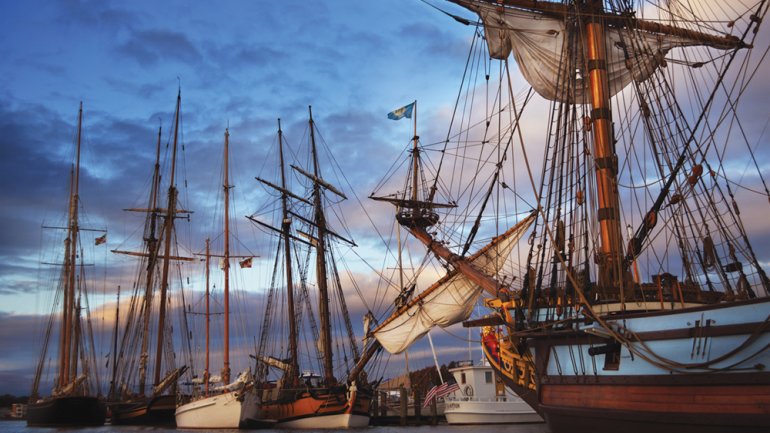Chestertown: Craft on the Chesapeake
Chestertown: Craft on the Chesapeake
Contemporary craft meets colonial charm in this coastal town.
The “middle of nowhere” by urban transplants, Chestertown, on Maryland’s Eastern Shore, is a 300-year-old riverfront town, steeped in history and alive with a thriving craft community. The town’s pedigree reaches back to colonial portraitist Charles Willson Peale, and it has since hosted accomplished artists and writers, from The Postman Always Rings Twice author James M. Cain to photographer Constance Stuart Larrabee and postmodernist giant John Barth.
Add the 230-year-old Washington College, several major weekend festivals a year, plus the stately silhouette of the schooner Sultana moored on the Chester River, and a snapshot of the town’s vibrant culture emerges. “Chestertown is about artists and craftspeople,” says Carla Massoni, owner of an eponymous gallery, a fixture of the Chestertown art scene for more than 20 years. “Why here? People come across the Chester River bridge and get it, or not.”
Many are immediately charmed by the town’s sense of history, its sycamore-shaded streets rife with tales of Washington and Franklin, the American Revolution, and the Civil War. A monument in the middle of town lists the names of residents who volunteered for both the North and South during the Civil War. But that’s not all that draws the creative community.
“Artists get it,” says Massoni, also noting the area’s rich Native American heritage. “Artisans here are in constant dialogue with each other, raising the bar at every opportunity.”
Two such local artists are Patti and Dave Hegland, who create kiln-formed art glass. David, a former engineer, and Patti, an accountant, ditched corporate life in Washington, DC, seven years ago and dedicated themselves to craft; Barneys New York now carries their work. Their studio, Hegland Glass, was also a recent stop on an art tour hosted by the Smithsonian’s Renwick Gallery.
Near Hegland Glass is River- Arts, a community arts center that champions established and emerging artists. The organization, which formed in 2012 with the union of two area art organizations, boasts more than 300 members and offers classes ranging from pottery to furniture painting. RiverArts also sells art, some made by its members, in its gift shop gallery.
A block away is the Tree of Life Gallery of American Craft. Founded by sculptor and potter Marilee Schumann and her sister, textile designer Faith Wilson, the gallery embodies the siblings’ philosophy that art should be taken off the pedestal and used in everyday life. The art they showcase includes rugs from regional textile artist Alice Pickett Lewis and art made at DC GlassWorks, a public studio near Washington, which lies about 75 miles southwest.
Just down the street, Robert Ortiz creates contemporary furniture in a signature style that marries Shaker and Japanese design. One of Ortiz’s tables includes stems of finely wrought metal ginkgo leaves by Rob Glebe. The artist, who has worked as a toolmaker and yacht service provider, creates ornate and delicate vessels out of brass, copper, and steel, as well as metal wall pieces.
A short walk down to Queen Street, a couple blocks from the Chester River, will take you to a renovated barn, home to Haywire Letterpress and Chester River Press. Both are letterpress design studios that merge art and literature. Chester River Press produces award-winning books, such as a limited edition of Joseph Conrad’s Heart of Darkness that features the work of local maritime artist Marc Castelli. Haywire Letterpress, helmed by husband-and-wife duo Matthew Swanson and Robbi Behr in collaboration with printer Jodi Bortz, produces beautifully illustrated broadsides and cards that lampoon everything from verboten swear words to relationships, all on fine cotton rag paper.
While tranquility suffuses this historic community, Chestertown’s collective momentum for self-improvement and self-expression burns white-hot. Public art initiatives, Rails to Trails extensions, a planned marina overhaul, a growing viticulture – to name a few – are all threads in the quilt of an ascending art identity.
Washington College often plays a significant role. The college’s diverse range of projects includes both the National Music Festival and the Sandbox Initiative, which investigates the intersection of art and environmental science, featuring work from artists such as Maryland sculptor John Ruppert.
The evolving art scene in Chestertown could warrant comparisons with other small art towns, such as Marfa, Texas. However, while Marfa’s allure began with a single artist (minimalist Donald Judd), Chestertown has grown piecemeal and organically over the course of three centuries. “I see the arts and Chestertown’s rich history as inextricably linked,” says Alex Castro, the director of Sandbox and a lecturer at Washington College.
Leslie Raimond and her late husband, Vince, were two of the pioneers of the Chestertown arts culture. With community projects too numerous to list, they also founded the Kent County Arts Council, which continues to flourish and to support craft artists, art projects, events, and group initiatives. The Raimonds recognized in the 1960s that Chestertown attracted highly skilled craftspeople and artists, and sought to amplify their success, winning NEA grants and establishing strong ties to art funding at the state level.
From the docks on the Chester River, visitors can stroll up High Street to Fountain Park to browse the outdoor craft and farmers market, step under the art deco marquee of Garfield Center for the Arts for a matinee performance, or have afternoon tea at the White Swan Tavern, before heading off to watch wood, glass, clay, brass, and canvas take new shape.
“Chestertown is still emerging – blossoming rather than fully bloomed,” Raimond says. “The community is recognizing that we are becoming identified as an arts destination, and that’s good for everyone.”
James Dissette is managing editor of the Chestertown Spy newspaper and a printer at Chester River Press.

